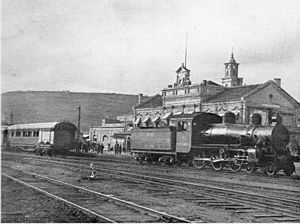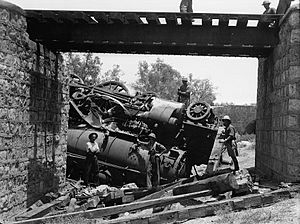Palestine Railways H class facts for kids
Quick facts for kids Palestine Railways H class |
|
 |
|
| H class 4-6-0 at Haifa East station in 1931 | |
| Power type | Steam |
|---|---|
| Builder | Baldwin Locomotive Works |
| Serial number | 50201, 50202, 50311–13, 50315–19, 50347–58, 50446–66, 50618–21, 50634–6 |
| Build date | 1918 |
| Total production | 50 |
| Configuration | 4-6-0 |
| Gauge | 1,435 mm (4 ft 8 1⁄2 in) standard gauge |
| Bogies | 6 ft 8 in (2,032 mm) wheelbase |
| Leading wheel diameter | 2 ft 9 in (838 mm) |
| Driver diameter | 5 ft 2 in (1,575 mm) |
| Wheelbase | 24 ft 9 in (7.54 m) |
| Length | locomotive 34 ft (10.36 m) from front buffer beam to drawbar; loco & tender 63 ft 1.4 in (19.24 m) over buffers |
| Height | 14 ft (4.27 m) |
| Axle load | 26 long tons (26.4 t; 29.1 short tons) |
| Weight on drivers | 15.8 long tons (16.1 t; 17.7 short tons); 17 long tons (17.3 t; 19.0 short tons); 16.4 long tons (16.7 t; 18.4 short tons) |
| Locomotive weight | 64.75 long tons (65.8 t; 72.5 short tons) |
| Locomotive and tender combined weight | 116.75 long tons (118.6 t; 130.8 short tons) laden |
| Fuel type | originally Welsh coal; converted to oil fuel by 1943 |
| Fuel capacity | 1,732 imperial gallons (2,080 US gal; 7,870 L) (after conversion to oil fuel) |
| Water capacity | Class H: 4,800 imperial gallons (5,800 US gal; 22,000 L) Classes H2 & H3: 2,350 imperial gallons (2,820 US gal; 10,700 L) |
| Boiler pressure | 190 lbf/in2 (1.31 MPa) |
| Fire grate area | 29.2 sq ft (2.71 m2) |
| Heating surface: Total | 1,659 sq ft (154.1 m2) |
| Cylinders | 2, outside |
| Cylinder size | 19 in × 26 in (483 mm × 660 mm) |
| Tractive effort | 24,479 lbf (108.9 kN) |
| Number in class | 50 |
| Locale | Mandate Palestine; northern Sinai; latterly Israel |
| Delivered | 1919–20 |
| First run | 1919 |
| Last run | 1960 |
| Retired | 1960 |
| Scrapped | 1960 |
| Disposition | 6 converted to 4-6-2T in 1926; 5 converted to 4-6-4T in 1933; 6 lost in accidents 1942; all withdrawn by 1960 |
The Palestine Railways H class was a powerful steam locomotive used for both passengers and goods. These trains ran on the Palestine Military Railway, and later on Palestine Railways and Israel Railways. They started working in 1919 and the last ones were retired in 1960.
Contents
Building and Arrival of the H Class
The Palestine Military Railway (PMR) was set up by the British Army during World War I. Its job was to run all the railways in the area. The PMR needed strong new locomotives because their old ones were not powerful enough.
In 1918, the PMR ordered 50 powerful trains from Baldwin Locomotive Works (BLW) in Pennsylvania, USA. British train builders were too busy with war orders to help. The first 10 trains arrived in Palestine in 1919, and the rest followed in 1920. These trains were given numbers 871 to 920.
In 1920, the British took over running Mandatory Palestine. The PMR was then replaced by a civilian company called Palestine Railways. They named these new trains the H class. The H class trains were good for most jobs, except for moving trains around in small areas (called shunting).
All these trains were painted black. From 1944, their numbers were painted very large on the side of their fuel tanks.
Changes and Upgrades
The train station in Jerusalem was quite small. It didn't have a way to turn around the large H class trains. This meant the trains often had to run backward, which was not ideal, especially on the curvy and steep tracks near Jerusalem.
To fix this, Palestine Railways decided to change some of the H class trains.
- In 1926, six H class trains (numbers 895, 904, 905, 909, 915, and 918) were sent to England. There, a company called Armstrong Whitworth changed them into a new type of train called a 4-6-2T tank locomotive. These new trains were named class H2 and numbered 7 to 12. They were good for the Jerusalem route but could pull slightly less weight than other trains.
- The original H class trains had steel fireboxes, which Palestine Railways found were not good enough. So, six more H class trains were sent to Armstrong Whitworth to get better copper fireboxes. Palestine Railways also made changes to other H class trains themselves, giving them different types of fireboxes and reducing the number of domes on top.
- In 1933, Palestine Railways opened its own workshops in Haifa. In 1937–38, they changed five more H class trains (numbers 881, 896, 897, 910, and 912) into another type of tank locomotive. These were called class H3 and had a 4-6-4T wheel arrangement, numbered 13 to 17.
Later Years and Retirement

In 1935, even more powerful trains arrived from Scotland, so the H class trains were used for less heavy work. During World War II, Palestine Railways carried a lot of supplies for the British and Allied armies. The H class trains worked very hard. Sadly, in 1942, six of them were lost in accidents. For example, train number 888 was badly damaged in a crash and later scrapped.
Originally, these trains burned coal. But in 1940, it became dangerous to ship coal across the Mediterranean Sea due to the war. So, Palestine Railways started changing its trains to burn fuel oil instead. This change was finished by 1943.
Even after World War II, the H class trains were still the most common and useful trains for Palestine Railways. During the 1947–1949 Palestine war, the railways were often attacked. The manager of Palestine Railways noted that these trains were repaired many times, even after being damaged, and kept working well for 28 years. This showed how tough the H class trains were.
After the British left Palestine in May 1948, all the remaining H2, H3, and H class trains became part of Israel Railways. Even though the H class trains were not designed to last a very long time, they served for about 40 years! By 1956, new diesel trains took over the main routes. The H class trains were mostly used in the central part of the country around Lod. Some H class trains were still working until 1959, and one, number 901, was even in service a few months after steam trains officially stopped running in Israel. All 44 of Israel Railways' H class trains were scrapped around 1960.
Images for kids


